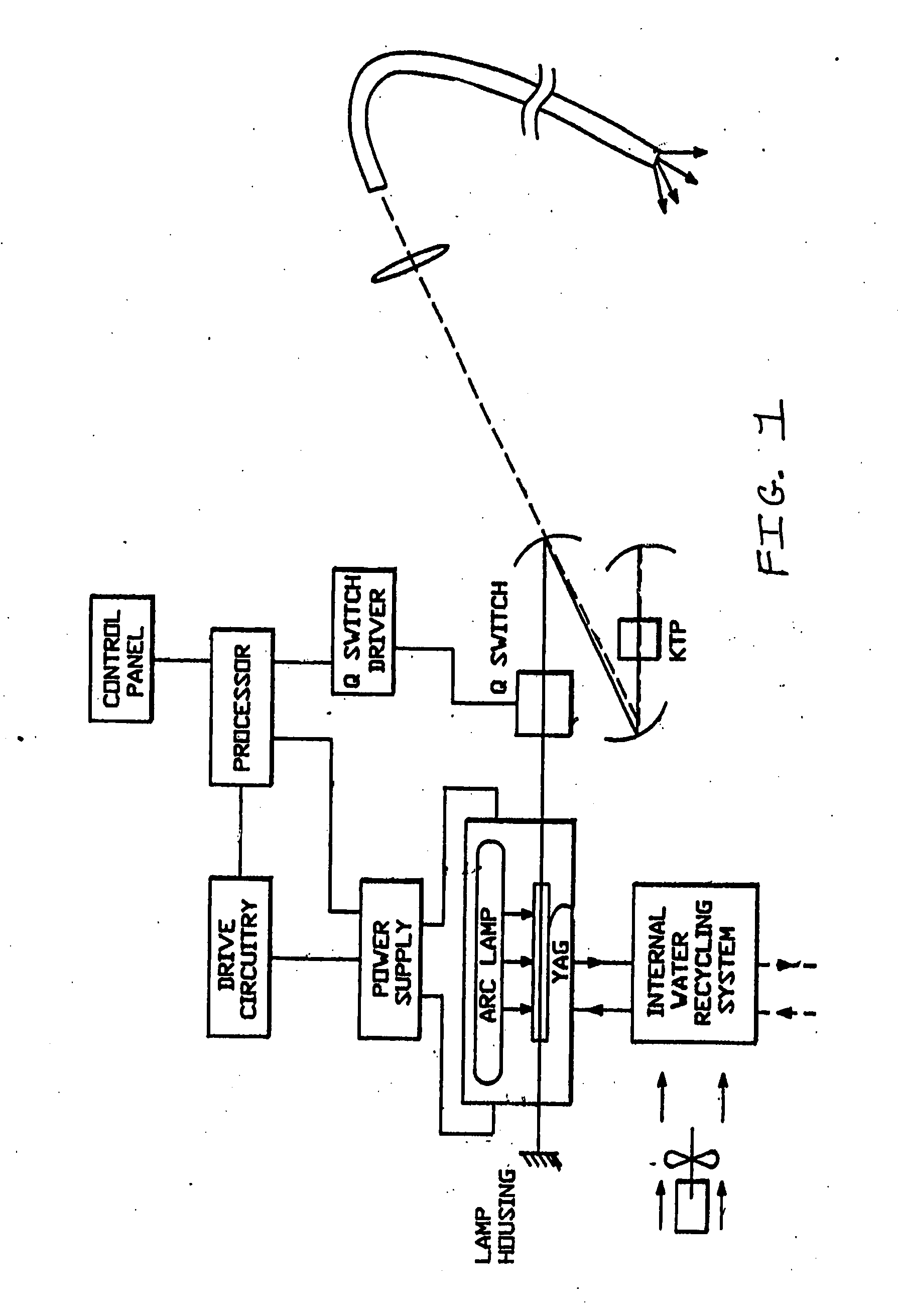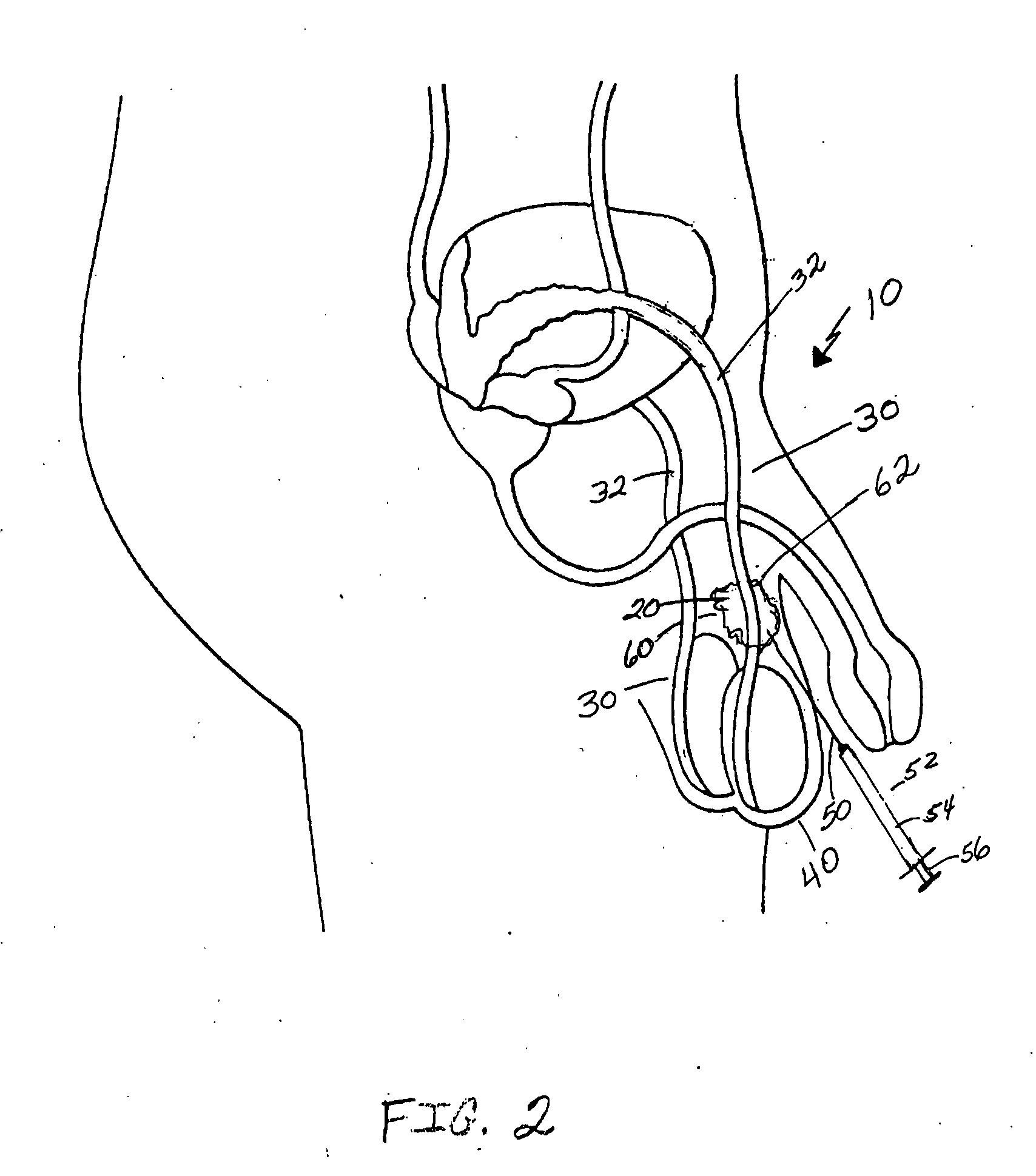[0011] The present disclosure is directed to the use of a laser to vaporize tissue to treat a variety of conditions, including, but not limited to incontinence, prolapse, fibroids, and
erectile dysfunction, as well as for contraception and sterilization. In various representative embodiments, a KTP (
potassium-titanyl-
phosphate) laser can be used to, for example, improve
blood flow in the
groin area by removing tissue that is obstructing
blood flow hence causing
erectile dysfunction; to remove the
prostate followed by use of an
anastomosis catheter; to eliminate small / medium
uterine fibroids or
hemorrhoids; to necrose tissue through a vaginal incision (or perineal for males) to cause scarring in the abdominal area to simulate what mesh does to help cure incontinence or prolapse; to remove the outer layer of the
uterus to eliminate menorrhagia; to vaporize other tissue masses (e.g. cysts) in the
gastrointestinal tract or other parts of the body; to conduct internal tubal ligations or tissue scarring to naturally create reversible occlusions in the fallopian tubes or to open the opening to the
fallopian tube; and to pinpoint and sever the
vas deferens to perform minimally invasive male sterilization.
[0013] In another aspect of the disclosure, male sterilization can be accomplished by severing the
vas deferens using
laser light tuned to a biocompatible colorant, the biocompatible colorant including but not limited to a dye, tint or
chromophore, that is injected in the vicinity of the
vas deferens. The laser is tuned / targeted to the biocompatible colorant and only vaporizes the tissue that is tinted with the biocompatible colorant. The vas deferens can be palpated and a needle can be inserted through the
scrotum and, as the needle is being pulled back from the vicinity of the vas deferens, the biocompatible colorant can be released in a small pocket of tissue surrounding the vas deferens. The biocompatible colorant remains in the track left by the needle during the time of treatment. A
laser fiber can be inserted in the vicinity of the biocompatible colorant and only the tissue tinted by the biocompatible colorant is vaporized.
Laser light, such as
green light (from a
KTP laser) at 532 nm,
holmium at 1064 nm,
thulium, or other appropriate
wavelength laser light, can be used. The vas deferens can be severed or damaged sufficiently to cause the walls of the vas deferens to collapse and become welded together to close off the vas deferens lumen. In some embodiments, the procedure can be performed at several points along the vas deferens lumen to ensure that the sterilization is complete and secure.
[0017] In the various previously described embodiments as well as those that follow, laser targeting of tinted, biocompatible colorant containing tissue can make use of the Greenlight
system from the Laserscope division of American
Medical Systems of Minnetonka, Minn., as well as other laser systems of appropriate wavelength. Generally, these laser systems can offer treatments in about the same or less time as current forms of male sterilization, and can be
less invasive than current forms of male sterilization. The lumen of the vas deferens does not need to be accessed, as when a tubal
ligation method or an
occlusion member
insertion method is used. Further, the biocompatible colorant does not need to be precisely placed and can be placed in multiple locations in the vicinity of the vas deferens.
[0019] In another aspect, it is not necessary to insert a
laser fiber in the vicinity of the biocompatible colorant to activate the biocompatible colorant to vaporize the tissue but instead, the
laser light can be focused from the exterior of the body, that is, percutaneously, so that the
laser fiber does not need to be inserted through the
cervix to be able to pinpoint the tinted, biocompatible colorant-containing tissue. The biocompatible colorant absorbs the laser light and, consequently, the tinted, biocompatible colorant-containing tissue is vaporized.
 Login to View More
Login to View More  Login to View More
Login to View More 


